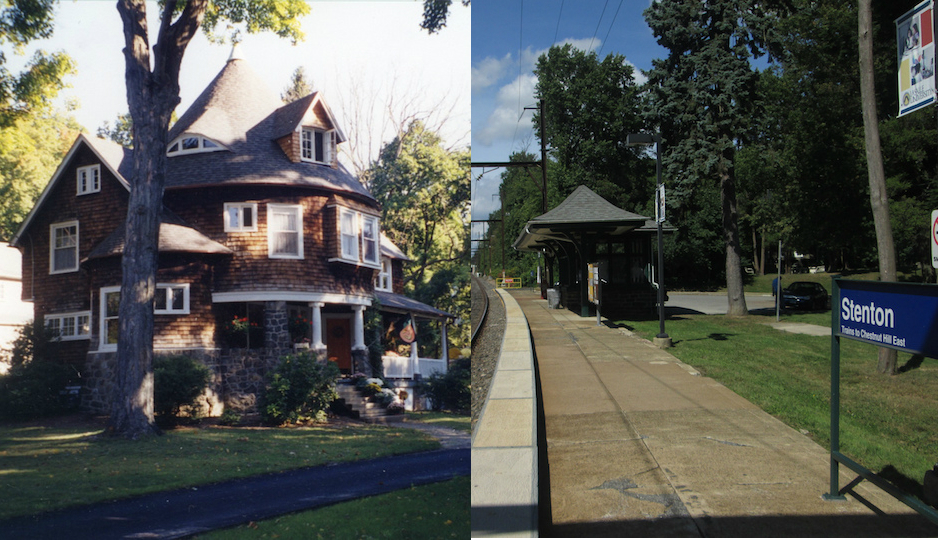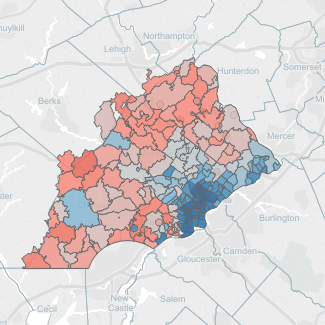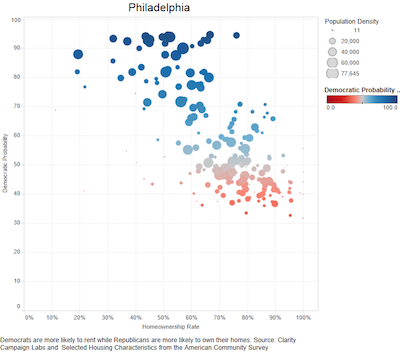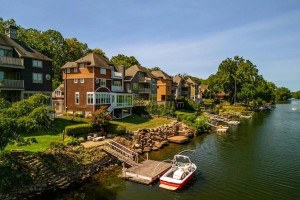Red Homeowners, Blue Renters: The Big Sort Comes Home to Philly

Red home, blue home: The homeownership gap between Democrats and Republicans is a little smaller in Philadelphia than in Cleveland because some affluent communities with high homeownership rates, like Wayne (left), lean Democratic (if only barely in Wayne’s case), while some overwhelmingly Democratic city neighborhoods like Stenton (right) have high rates of homeownership. | Photos: Home in Wayne by Tim Engleman, Stenton Station by Adam Moss, licensed under CC-BY-SA-2.0
So you own a lovely restored farmhouse in bucolic Buckingham, a rancher in Richboro or a cabin in Concordville? You’re probably a Republican, though if you live in Eddystone or Crum Lynne, you may be a Republican renter.
And if you’re a Democrat, chances are you’re paying rent to some landlord in Rittenhouse, Washington Square West or even Chestnut Hill. Unless, that is, you live in Stenton, where you’re much more likely to own your home.
The folks at Redfin decided to take the occasion of our national political conventions to see if they could find a red-blue homeownership divide in the host cities, and they did. While both Ohio and Pennsylvania are considered swing states that will be battlegrounds in the upcoming Presidential election, the homeownership patterns in both Cleveland and Philadelphia have a more decidedly partisan cast to them.

Voting tendencies by ZIP code: blue districts tend to vote Democratic, while red ones lean Republican. The darker the shade, the stronger the tendency. | Source: Clarity Campaign Labs
Working with data from Clarity Campaign Labs, a Democratic analytics firm that scores ZIP codes according to their voters’ political leanings, Redfin found that the city cores of both Cleveland and Philadelphia are a deep blue that fades as one heads outward until the further-out suburbs turn red. But this is nothing new really. What’s more interesting is the correlation they found between partisan leanings and homeownership: in both cities, Republicans were more likely to own homes than Democrats were, and the homes the Republicans owned tended to be bigger, pricier and on larger lots.
While the average level of homeownership in both metropolitan areas is above the national average of 63.5 percent (based on Census Bureau figures), it’s significantly lower in Democratic-leaning ZIP codes than in Republican ones. The gap in Philadelphia, however, is smaller than that in Cleveland: while the average homeownership in Democratic ZIP codes in Cleveland was 59 percent compared to 83 percent in Republican ones, the figures in Philadelphia were about 62 and 79.5 percent respectively.
The smaller gap in Philadelphia may arise from two factors. One is the presence of several Democratic-leaning ZIP codes with high homeownership in the collar counties, especially Montgomery, home to affluent Merion Station (19066) and middle-class Cheltenham (19012), and Bucks, where the communities close to the Delaware tend to lean Democratic, including Levittown (19055) and Yardley/Morrisville (19067).

Homeownership rates in city ZIP codes. Dot size indicates population density. | Data: Clarity Campaign Labs
Another is the relatively higher rate of homeownership in the city as a whole. Overwhelmingly Democratic city neighborhoods with high home ownership rates include the aforementioned Stenton (19150, where 76 percent of residents own their homes) and East Germantown/West Oak Lane (19138, where this reporter lives and the homeownership rate is 67 percent).
But the gap is there nonetheless, and as Redfin Senior Managing Editor Lorraine Woellert put it, that’s a problem.
“We’re self-gerrymandering, and that poses problems for our politics,” she said. Because we’re sorting ourselves into like-minded political enclaves locally as well as nationally, “we can’t compromise or agree on anything. Separation by place is contributing to our separation by policy.”
Then there’s the gap in house values. The average home in a Republican-leaning ZIP code in the Philadelphia region sold for nearly $197,000, according to Redfin data, while in Democratic ones, the average home went for about half that price, $99,000.
A Redfin blog post on the partisan homeownership gaps explains that some of the reasons for this ideological sorting-out have to do with housing and lifestyle preferences — Republicans tend to prefer bigger homes on larger lots in more spread-out communities while Democrats like denser, more walkable communities with smaller homes — and some have to do with demographics: liberals tend to be younger, less white and less affluent than conservatives.
“It isn’t necessarily that homeownership is directly connected to partisanship, but all the demographics around being likely Democrat — being younger, less white, slightly lower income — tend to correlate with slightly lower homeownership,” Clarity co-owner David Radloff said in the post.
This local version of the Big Sort also makes it harder to adjust our housing policy so that it encourages upward mobility and homeownership among those who would most benefit from it. Maybe this can be a talking point at some of the events surrounding next week’s Democratic National Convention.
Republicans Are More Likely to Own Homes and Other True Cliches (Redfin)
Follow Sandy Smith on Twitter.


